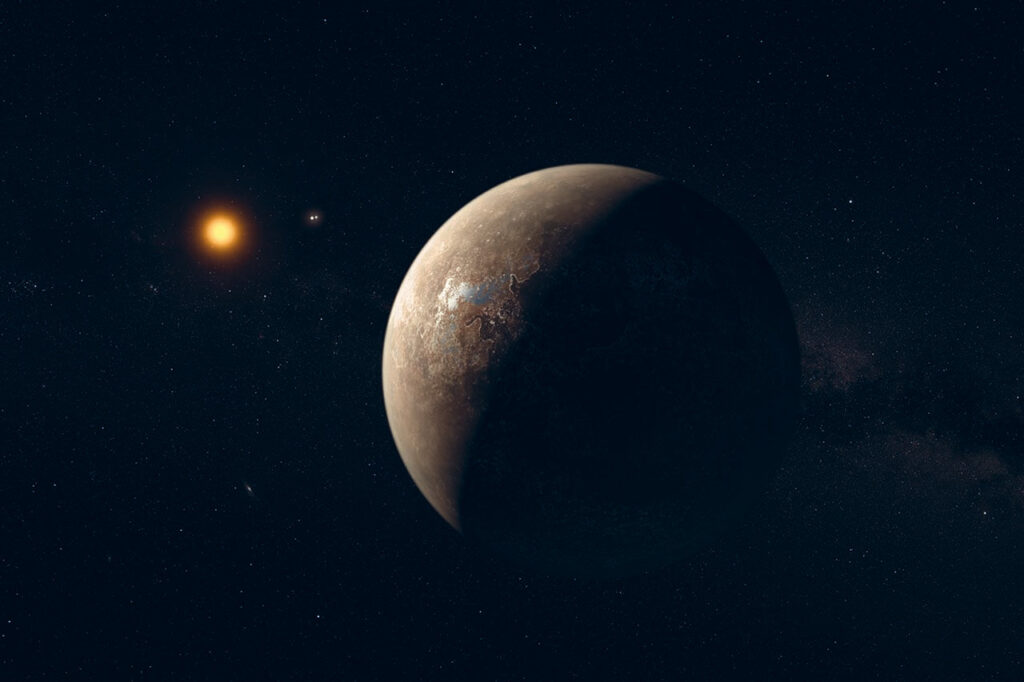[LUM#5] Proxima b, the invisible beauty
It could harbour life. Just a stone's throw away, Proxima b rekindles an old dream: that of discovering other habitable planets outside our solar system. But what exactly is a habitable planet?

It's the closestexoplanet to Earth. As with most of its fellow exoplanets - there are now over 3,000 - Proxima b has never been observed. The distance and lack of luminosity of this celestial object drowned in the light of its star make direct observation impossible. A planet, therefore, invisible to the naked eye, yet one that sparkles with a special brilliance for astrophysicists...
So close unknown
The fruit of a decade's worth of data compilation and analysis, its discovery last August sparked excitement well beyond the astrophysical community. Why all the excitement? Because this planet is exceptional for at least two reasons. First, its proximity. The aptly-named Proxima b orbits Proxima Centauri, the nearest star to our solar system, located "only" 4 light-years from Earth: a quantum leap on the scale of the universe.
Then there's its Earth-like nature, with a composition that is likely to be rocky and a mass roughly equivalent to that of our planet(Proxima b, a potentially habitable rocky exoplanet, UM website, 2016). "The discovery of extrasolar planets1 that could potentially harbor life is nothing new. What is new is the proximity of this planet, which in a few years' time will enable us to directly observe for the first time the interactions between a planet resembling our own and its star", summarizes Julien Morin, researcher at the Montpellier Universe and Particles Laboratory and member of the international team behind this historic discovery (" A terrestrial planet candidate in a temperate orbit around Proxima Centauri", in Nature, 2016).
A dream playground for astrophysicists, and a source of hope: " this discovery concerns the system closest to the solar system. If this is home to a planet of this type, then we can reasonably assume that many others exist around us," notes the researcher.
"Livability zone
A habitable planet just a few space miles from Earth? Nothing could be further from the truth. To qualify as a habitable planet, Proxima b would have to meet a series of criteria that are currently unverifiable. As is often the case in astrophysics, the information gathered on Proxima b is based on deduction rather than direct observation. "By studying the star, we were able to measure frequency shifts in the light emitted by it, and thus deduce that a planet orbited it. We were also able to estimate the planet's mass," explains Julien Morin. A mass around 1.3 times that of the Earth suggests a telluric composition, making the presence of life conceivable.
However, it's not enough for a planet to have solid ground for humans to set foot on it. Its surface temperature must be within a temperate range to allow the presence of water, and therefore life ( The hability of proxima Centauri b, in Astronomy and astrophysics, 2016). In the case of Proxima b, scientists were able to estimate a distance of 7 million kilometers between the planet and its star, Proxima Centauri. A much smaller distance than that separating the Earth from the Sun, which nonetheless places Proxima b in the so-called "habitable zone". But why? Because its star, a red dwarf, is seven times smaller and a thousand times less luminous than our Sun. It would therefore seem possible that the planet's surface temperature is such that water could flow through it in a liquid state.
Atmosphere, atmosphere...
One crucial point remains: the existence or not of an atmosphere, the gaseous envelope that insulates the planet from the vacuum of space, regulating its temperature and enabling the formation of clouds and rain thanks to the greenhouse effect. " It is currently impossible to know whether or not Proxima b has an atmosphere, a necessary condition for maintaining water in a liquid state," explains Julien Morin. The short distance separating Proxima b from its star poses a problem here: because of their proximity, the planet is likely to be bombarded by an enormous quantity of X-rays and ultraviolet radiation, with red dwarf stars erupting far more violently than our Sun. Hence the fear that Proxima b's atmosphere - if it ever existed - may have been reduced to nothing by this stellar radiation.
There are still many grey areas, which the forthcoming launch of a new generation of "super-telescopes" could soon shed light on. As for the prospect of one day visiting our galactic neighbor, it seems far more uncertain: with current propulsion technologies, it would take tens of thousands of years to reach this planet, which is so relatively close. An eternity, unless a technological leap changes all that. This is the dream of Russian billionaire Yuri Milner, whose Starshot project aims to develop postage-stamp-sized nano-probes propelled by photonic sails and a laser beam. Although many technical hurdles still need to be overcome, these probes could one day reach unprecedented speeds of around 20% of the speed of light. Proxima Centauri could then be reached... in around twenty years! So now, more than ever, we can dream.
UM podcasts are now available on your favorite platforms (Spotify, Deezer, Apple podcasts, Amazon Music...).
- An exoplanet, or extrasolar planet, is a planet-like celestial body orbiting a star other than the Sun
︎